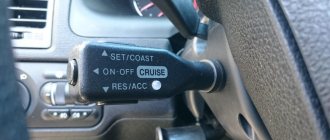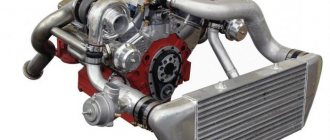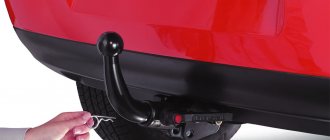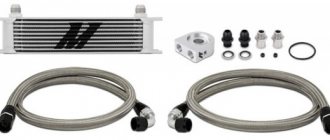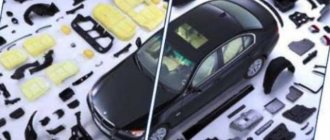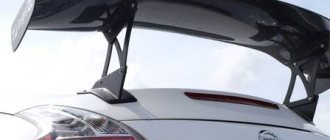Launch control from A to Z: what it is, how it works, what it’s for
Modern cars include an installation called launch control, which allows you to control the vehicle’s power plant. The unit is an extremely complex product, capable of controlling various components - this allows the driver to concentrate on the task.
However, it's not just racers who can benefit from the product - everyday commuting can also require instantaneous acceleration that isn't possible with normal throttle input.
Launch Control - involves starting the vehicle without slipping, helping to accurately distribute engine power.
History of launch control creation
Instant start is an excellent quality of professional drivers, available only to racing aces. The mastery and development of technology was provoked by the evolution of telemetry. In 1985, the Renault team was able to create technology that allows signals that optimize the operation of systems to be transmitted remotely. Previously, it was only possible to read information, without any assistance in the race.
Years later, the development of technology forced the FIA corporation to ban the use of such an innovation for participants in Formula 1 teams. According to experts, electronic assistants significantly reduce the level of pilot skill, which negatively affects the quality of races.
Then there were years of controversy and debate that led to the implementation of the development. After which, at the end of 2004, the federation again canceled its decision, justifying it with the excessive cost of launch control for low-budget teams. The development price tag will not be affordable for simple organizations, which can lead to a significant reduction in the number of competition participants.
Why do you need launch control?
The answer to the question why this device is needed is simple. The presence of launch control in the car implies the ability to accurately calibrate the speed of the power plant to make an instant start while minimizing the effect of slipping.
The benefit of the technology is especially pronounced in racing modes, where fractions of seconds count. For example, the operation of the unit is especially in demand in drag racing.
The idea is simple, for an optimal start the rider needs to maintain optimal speed to make an ideal start. Immediately after starting to move, full throttle is required to effectively gain speed.
So, the main essence of the work of launch control is to perform all the necessary actions at the right moment, for minimal loss of time on start and acceleration, fully automatically, without user intervention.
How launch control works
The essence of the installation is based on the ability of the power unit to automatically maintain speed at a given level, followed by a sharp acceleration of the value to the limit.
Launch control is applied automatically due to the ability of electronics to control the process.
On production vehicles, the user simply presses the brake and gas pedal. The automation brings the speed to the desired level, and after releasing the brake, the car rushes forward. However, the device independently determines the necessary parameters - this is due to the fact that an inexperienced user can damage the automatic transmission unit with such actions.
Important! The operation of the device is most effective on engines equipped with an injector.
How to enable and use Launch Control
Depending on the modification of the vehicle, the principle of activation of the block may differ. But the general rules are approximately the same for all models.
- Warm up the power unit and gearbox to the nominal value.
- Set the gearbox position to sport.
- Disable the directional stability option, otherwise the unit will fail.
- Press the brake to the floor.
- Without releasing the brakes, press the gas all the way.
- Wait until the engine reaches 3.5 - 4.5 thousand rpm. The indicator depends on the vehicle model.
- Smoothly release the brake.
If everything is done correctly, the car will begin to rapidly accelerate until it reaches maximum speed. To reset, you just need to let off the gas.
Important! The correct operation of the unit depends on the correct manipulations of the driver. Before starting, you must carefully study the factory manual.
Setting up Launch Control
The function setting is available exclusively to race car drivers. It is possible to calibrate the actuation moment and the number of engine revolutions.
During manipulations, the rubber composition, road surface, and air temperature are taken into account.
On serial-type models, the manufacturer enters the necessary data into the firmware; the end user can only activate or disable the option. This is done to ensure that the user does not damage the CP due to lack of knowledge and experience.
Using launch control in production cars
For production cars, the option is available only to top versions of sports cars or at the whim of the manufacturers. The technology has not found widespread use due to its unusually high cost.
Vivid examples where the automatic start function is installed are the following:
- BMW M/X series;
- Bugatti Veyron;
- Porsche 911;
- Nissan GT-R;
- Mitsubishi Lancer X;
- Volkswagen Tiguan;
- Skoda Octavia.
It is also worth noting the most famous manufacturers of automatic start units for cars and motorcycles. These are corporations:
Important! Obtaining an effect similar to the operation of the device can be obtained by honing the skill of working with the gas and brake pedals.
Automatic launch control
The technology is used on automatic transmissions only of a certain type. A conventional automatic transmission cannot provide the necessary parameters due to the inadequacy of the design.
However, with the advent of dual clutch systems, engineers noticed that the designs were subject to modernization. This prompted the use of the design. Launch control on this type of machine is installed by global companies.
Source: https://autodont.ru/jelektro/launch-control
Step-by-step instructions for use
Activating the option may differ slightly for different car brands, but the sequence of actions when enabled is approximately the same.
| Step #1 | Warm up the gearbox and engine to nominal levels |
| Step #2 | Switch the gearbox to the “Sport” position |
| Step #3 | Disable stability control |
| Step #4 | Press the brake and gas pedals |
| Step #5 | Wait until the engine speed reaches 3500 rpm and slowly release the brake |
If all actions are completed without errors, the car will instantly begin to accelerate until it reaches its maximum speed. To slow down, you need to release your pressure on the gas pedal.
Tips for launching a mobile game: Part 1, Soft launch
In mobile games, a soft launch is often crucial - especially now, when app stores are oversaturated and you have to invest a lot of money to attract users.
Using a soft launch, you can understand how well the game will be received by users in the event of a global launch, and roughly estimate the costs of its marketing. However, a soft launch can be a time-consuming process - it is not always obvious what to do and what to avoid.
In 2021 alone, we at Nexon held a soft launch of about a dozen games. Through trial and error, we figured out what worked best for our games. Here are some of our best practices.
What is soft launch?
Soft launch occurs before the official launch of the game worldwide. Developers release the game in select regions similar to their target market in order to ensure a successful global launch. You can regard this as training or testing.
Checklist for soft launch
Define the main tasks
It is important to understand that soft launch is primarily a learning process. During this time, you prioritize speed and pure data over ROI, which you can focus on later during the global launch. Your main goal is to collect fast and clean data to make better business decisions later. This data will help you determine your betting strategy and map out your game's LTV curve.
How the system works
Its action is based on the ability of the power unit to maintain speed at a certain level, and then perform instant acceleration to the maximum values. In automatic transmissions, the ability to quickly start has appeared thanks to the ability of electronics to fully control this process.
In production cars, the driver presses both the brake and the gas at the same time. At this time, the automation allows the engine to gain the required speed. When the brake is released, the car instantly takes off. To prevent damage to the transmission at this moment, all parameters of the vehicle’s launch and movement are electronically controlled.
What is the value of a soft launch for the application owner?
In an environment where mobile app marketing is becoming more expensive and the cost of acquiring users is rising, the issues of preliminary testing of marketing campaigns and the success of the application as a whole are becoming especially important. One way to test the operation of an application or game and explore all aspects of its marketing without incurring large expenses is a soft launch.
Why it's important to do research before the big launch
Marketing is a rather expensive process. And we are talking not only about the money you invest in promotion, but also about the labor costs for creating promotional materials, ASO, community development, communication with the press, influencer marketing, etc. All of these tasks require a lot of time and effort. By doing it at random, you run a very high risk of not getting into the target audience and wasting your efforts and money.
Conducting research will allow you to obtain preliminary data on the operation of the application, identify bottlenecks in which users get stuck or abandon it altogether, predict LTV and CPI, draw up a promotion strategy, formulate and confirm theories about your target audience.
What is a soft launch?
Soft launch (soft launch) - releasing a product (game or application) and testing its operation for a limited market (audience).
In fact, this is a test of your product in combat conditions in order to determine the main parameters of its operation. This is an attempt to predict the future of an application based on a small test group. “You don’t get a second chance to make a first impression,” and the soft launch is just practicing this first impression on a small audience before the global launch.
Typically, a soft launch is conducted in a country that is most similar to the target market, but smaller in size and cheaper in terms of user acquisition costs. For Europe, for example, Finland is often chosen. For Asia - Thailand or Vietnam, and for the USA - Australia or Canada. However, it is quite possible to conduct such testing simply on a relatively small group (one or several states in the USA).
It is important to correctly assess the relevance of this group to the future “large” user base. For example, if you gather several thousand users through a game announcement on a website for developers, then this group will be sufficient for a soft launch, but not at all relevant if your game is intended for teenagers.
Soft launch goals
You'll likely have your own goals for this kind of beta testing, but in general you'll want to answer a few key questions about the product before release:
- How willing are people to click on app ads?
- What creatives of yours work best?
- Is it easy to “sell” your product to your audience?
- Which demographics does the app resonate best with?
- What applications does this segment currently spend its time in and will you be able to squeeze out your competitors?
- At what scale can the application remain profitable?
- How big and profitable can it become?
- How viral is the product?
- Do users share information about it?
When conducting such studies, ensure that the metrics collected are reliable, reflect the quality of the product, and are not the result of chance. By the end of the soft launch, you should have a sufficient amount of data on the behavior of users targeted for your product, their churn, and key indicators of effective marketing. This information will confirm your product hypotheses, and will also help you quickly make the necessary changes to the product before the official launch.
Video on the topic
—>
Modern cars include an installation called launch control, which allows you to control the vehicle’s power plant. The unit is an extremely complex product, capable of controlling various components - this allows the driver to concentrate on the task.
However, it's not just racers who can benefit from the product - everyday commuting can also require instantaneous acceleration that isn't possible with normal throttle input.
Launch Control - involves starting the vehicle without slipping, helping to accurately distribute engine power.
Launch control: what it is and how it works
It's no secret that modern cars are simply “stuffed” with all kinds of electronic systems to assist the driver. More recently, a car owner could be proud that his car is equipped with an anti-lock braking system (ABS), and the presence of an exchange rate stability system (ESP) put his vehicle on the same level as a spaceship or Mars rover. This is of course a joke, but it really reflects the state of things in the domestic automobile market in the 2000s.
Next, I will talk about an assistant that has recently become available to a wide range of motorists - launch control.
Purpose
Launch control (launch control) is an electronic system that allows you to achieve the most efficient start of a car from a standstill. This is achieved by controlling the fuel supply and ignition systems.
In other words, the Launch control system raises the engine speed before the start of movement, so that in the process of starting from a standstill, the engine has already reached the speed necessary for an effective start. This is especially true for turbocharged engines, where the turbine needs to spin up, so to speak, “inflate”. The use of this system practically equalizes the start of an experienced racer and a novice driver. Launch control eliminates driver errors when starting, and also allows you to use engine power and torque as efficiently as possible.
Engineers have been thinking about the development of this system almost since the appearance of the first races. And when such a type of competition as Drag Racing, where you need to overcome 402 meters as quickly as possible, began to gain popularity, it was simply impossible to do without a launch control system in the car. After all, the entire race lasted just over 10 seconds, and the winner was often determined by hundredths of a second. A participant who made a mistake at the start most likely lost the entire race.
How does it work
The principle of operation is that the engine speed at start is kept at the maximum torque mark. As a rule, this is 2000–4500 rpm.
Until recently, Launch control was used only on cars equipped with a manual transmission. This is due to the fact that automatic transmissions were either hydromechanical automatics or CVTs, where the clutch function was performed by a torque converter.
I will not go into the design features of the torque converter and will immediately move on to the most important thing, and this is that the torque converter extremely does not like increasing speed at the start and this greatly affects its service life.
It was only in the early 2000s that the Launch control system began to be used on automatic transmissions. This became acceptable due to the widespread use of another type of automatic transmission - preselective robotic gearboxes, the most famous of which is DSG (aka s‑tronic) from the VAG concern (Volkswagen, Audi, Skoda, Seat). Structurally similar gearboxes are available in BMW, Porsche, the Japanese - Nissan GTR, Mitsubishi Lancer Evolution 10, and even recently the Koreans.
Structurally, these boxes are more similar to mechanics and do not have the disadvantages of hydromechanical gearboxes.
By the way, if your car is not equipped with launch control, then it is quite likely to find the firmware of the engine control unit, where this system will be registered.
Application of Launch control or how to enable it
Let me make a reservation right away that there is no key as such to turn on Launch control. However, certain actions must be taken and conditions must be met:
- Starting from launch control must be carried out with a warm engine and gearbox, that is, it is not enough to stand for 10–15 minutes with the engine running, since in this case only the internal combustion engine will be warmed up, you need to drive at least 10 km so that the gearbox also operates at the required temperature mode;
- Disable the ESP stabilization and stability control system; Switch the gearbox selector to S (sport) mode;
- Leave your left foot on the brake pedal, and move your right foot, which was not previously used, to the fuel pedal;
- Press on the gas (the system will set the number of revolutions itself) and release the brake; Enjoy lightning-fast acceleration)))
I wanted to add a few words about safety to make overclocking safe. Launch control is not installed on all cars; it is installed on powerful and high-speed cars. Therefore, during intense acceleration, make sure that the road surface allows maximum torque to be realized on the drive wheels and that rapid acceleration will not interfere with other road users.
Now you know what launch control is, I hope the article was useful to you. See you soon!
Andrey
Source: https://avto-kul.ru/poleznoe-ob-avtomobile/launch-control.html
Launch control...
There is a debate about what launch control is. How to explain it correctly and clearly. I understand what it is, but I can’t say it! Thank you.
- 25.10.2007 15:49 #2
d71
Address: Blagoveshchensk Posts 2,715
no, you don't understand
